Every year, I love keeping an eye on the UEFA Youth League competition. It can feel like a break from all the noise surrounding the actual UEFA Champions League and all the talking points that competition generates in the media while still giving us a chance to see some of Europe’s best in competition, albeit Europe’s best youngsters rather than best players overall.
In addition, the competition always throws up some new names that catch the eye and warrant some attention from that point on via their performances;
In addition, the competition always throws up some new names that catch the eye and warrant some attention from that point on via their performances; PSG forward Gonçalo Ramos’ 2019/20 UEFA Youth League showing with Benfica is one that sticks in my mind as a great example of how this tournament can provide a platform for promising talent to truly begin shining on a continental stage.
Last season, AZ Alkmaar emerged victorious from the UEFA Youth League under the guidance of Jan Sierksma, a coach who won everything there was to win at U19 level with AZ, including two Dutch U19 youth cups and the Dutch U19 youth league.
This term, he has moved on to coaching Jong AZ in Eerste Divisie and, at the time of writing, has them sitting 12th in the Dutch second-tier — mid-table. Managing Jong AZ is a unique managerial experience as they constantly compete with senior teams hoping to challenge for promotion to the Eredivisie, yet are ultimately a team full of youth players subordinate to the senior team just one division higher whose main focus must be on player development rather than purely on wins and losses.
Nevertheless, Sierksma has achieved plenty of player development and his fair share of victories with Jong AZ this term. Coupled with his UEFA Youth League success earlier this year, he’s enjoyed a 2023 to remember.
With that said, with his inclusion in this magazine, you can see that we feel the 39-year-old is set for even bigger and brighter things in the future and remains one to watch as we enter 2024.
So, this tactical analysis piece will investigate Sierksma’s approach to coaching, primarily from a tactical perspective, particularly focusing on his time with Jong AZ this season. We’ll analyse how he’s set his team up to play in different phases of play, with our article split up into three sections — in-possession, transitions and out-of-possession. We aim to emphasise key aspects of his tactics in all phases based on how we’ve seen his team perform on the pitch in 2023/24.
In-possession
We’ll start by examining how Sierksma’s young side performs in possession. Firstly, Jong AZ have pretty much exclusively played in a base 4-2-3-1 setup this season. Of course, that varies depending on the phase of play we find them operating in at any given time, but generally, that shape has been consistent.
Additionally, before we get into the details of their in-possession approach, we should clarify some basic aspects of their play.
Jong AZ have been the fifth-most possession-dominant team (52.8%) in the Netherlands’ second-tier in 2023/24; I wouldn’t describe them as being an extremely dominant team on the ball by any means, however — from our analysis, we’d say this is mainly down to their careful play in the build-up designed to draw opposition pressure high, opening up space further upfield for their attackers to hopefully exploit as they’re found via a progressive pass or long ball forward.
Sierksma doesn’t want to see his team giving the ball away if they can help it; it’s a clear principle of his to reduce cheap loss of possession. This has resulted in AZ making it to this point of the season with the Eerste Divisie’s second-highest pass accuracy (84.2%) and fewest ball losses.
Of course, this can lead to some fairly safe play — perhaps a bit too safe, at times — but the goal is to reduce cheap loss of possession that can lead to very dangerous transitional attacks for the opponent, and they’ve achieved this successfully.
With that context in the bag, let’s move on to some deeper tactical analysis of how Jong AZ put their in-possession principles into practice on the pitch.

In build-up, we’ll often see Sierksma’s side looking something like what we see in figure 1, with the centre-backs split close on either side of the goalkeeper, the full-backs maintaining the width outside, and the midfield three staggering to operate on different lines to one another. Typically, one holding midfielder drops into a central position between the centre-backs. At the same time, their partner might move ever-so-slightly higher, while the ‘10’ is free to roam about and occupy space where they feel they can be most effective.
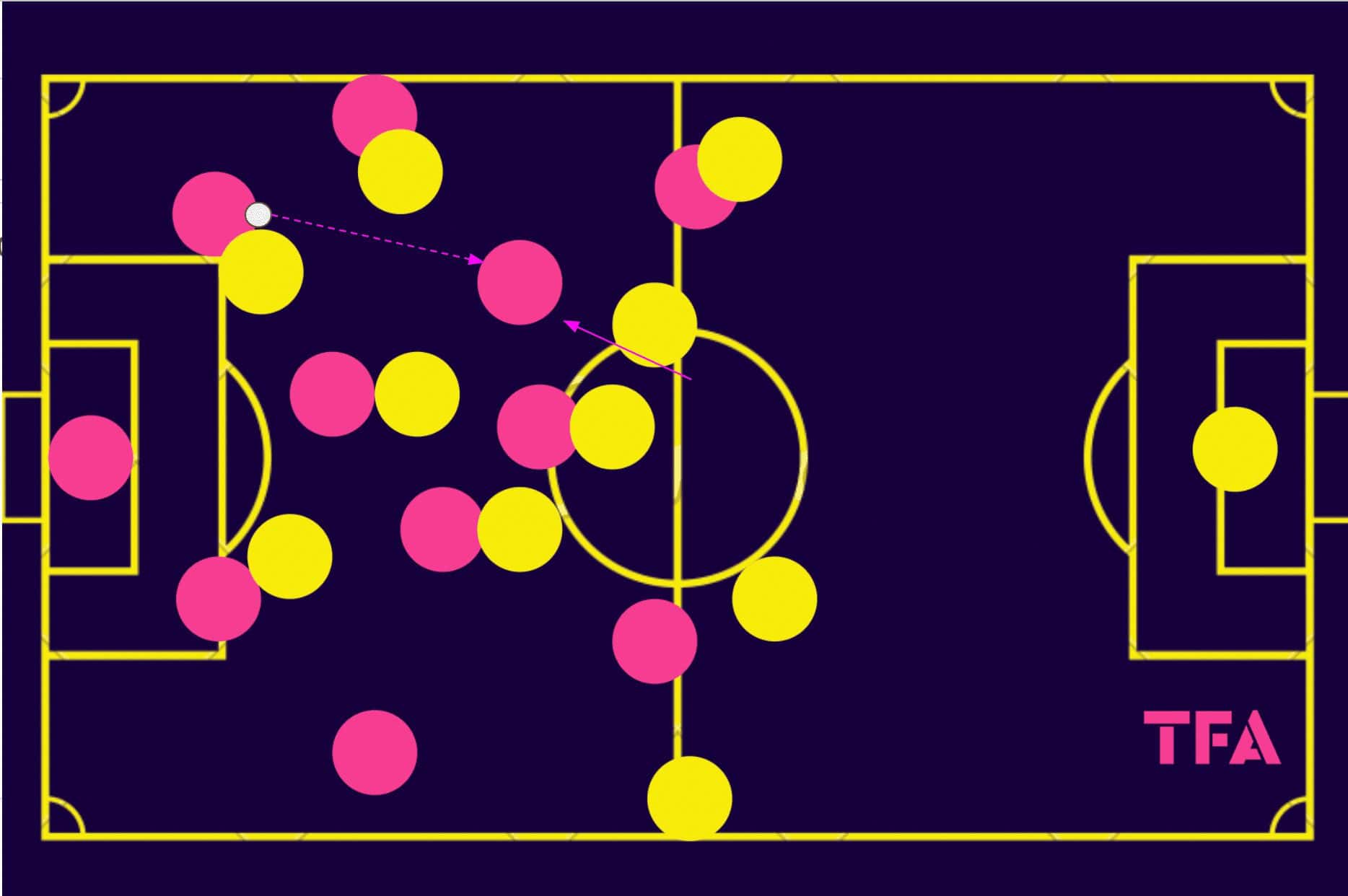
We see an example, this taken from Jong AZ’s recent game versus Cambuur, of how this may work in practice versus an opponent here in figure 2. In this case, the left centre-back is on the ball, coming under some heavy pressure from the opposition forwards.
The ball carrier had no clear passing options available until the centre-forward, Mexx Meerdink, dropped to form the tip of a diamond that gave the left centre-back a clear progressive passing opportunity through the left half-space.
As Meerdink dropped, he was followed by the opposition’s right centre-back, but not immediately. This gave the forward time on the ball to get his head up and/or turn after receiving, as well as creating a big hole in the opposition’s backline for AZ’s wide forwards to move inside and attack.
Jong AZ have played the fewest crosses of any team in the Eerste Divisie this term. Their style of chance creation this term has been much more about off-the-ball movement to create connections and open up space that can help them carve through the middle of the park and find a way through to goal via these valuable central areas, as we can see in figure 2.
Furthermore, while their left-winger, Ro-Zangelo Daal, has operated more in wider areas and been somewhat of a traditional winger, the right-winger, primarily Ricuenio Kewal but sometimes Jayden Addai — the latter of whom is very much on the verge of breaking into AZ’s senior team — have been inside forwards looking for opportunities for out-to-in runs and make their way into goalscoring positions who would thrive if given the space afforded to them here by the opposition’s right centre-back.
Still, all wingers will take the chance to move inside and exploit space like this, particularly in a fast-moving attack like this one, which is essentially bypassing the chance creation phase altogether and could be described as something of a ‘micro-transition’, so make no mistake about it, the left-winger will be making the inside run here.
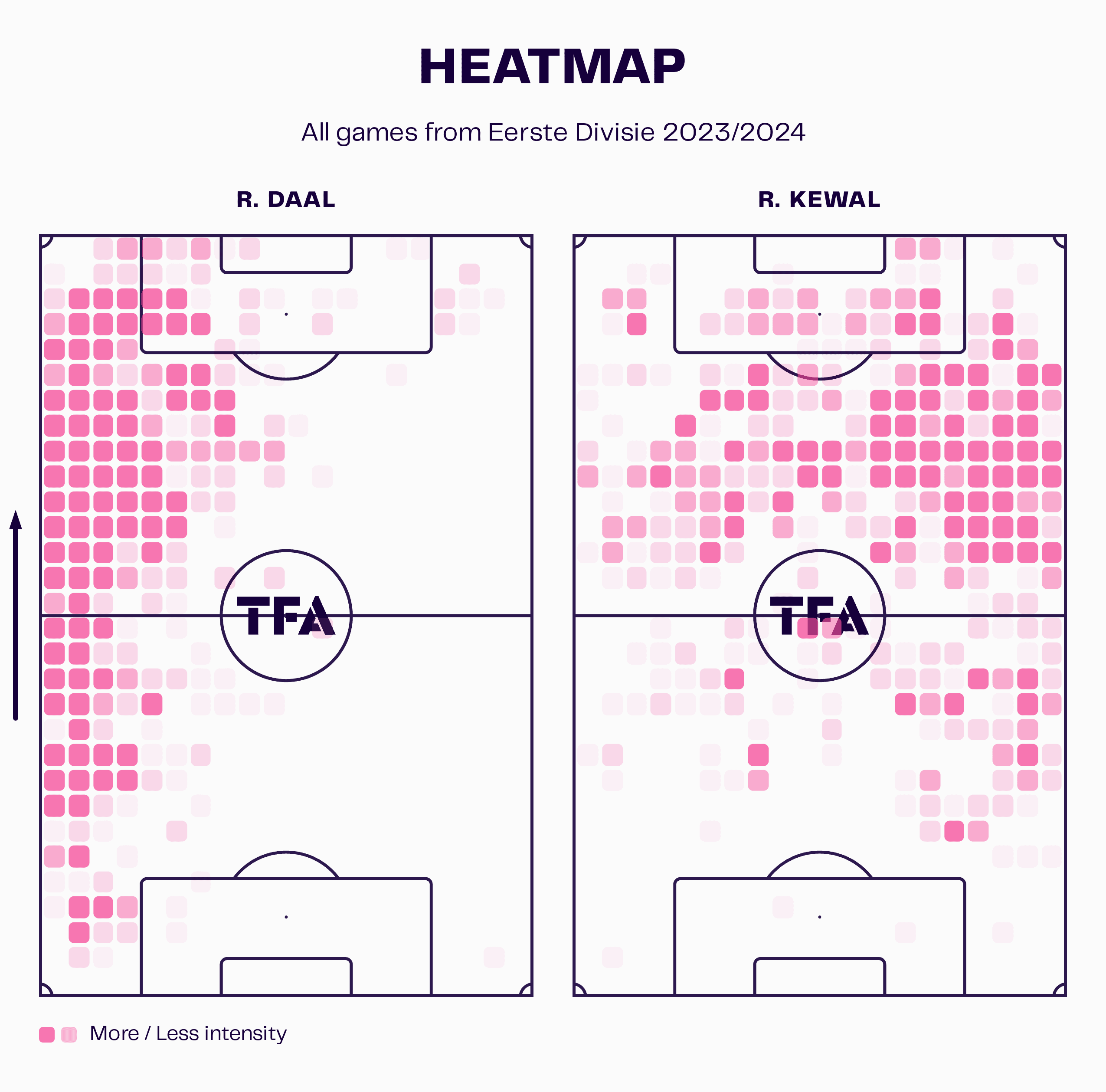
We can see a contrast between Daal’s typical winger positioning and Kewal’s inside forward movement in figure 3. Indeed, the left-winger in Sierksma’s side is asked to hug the touchline more heavily while the right-sided attacker is given the licence to move inside more.
As mentioned, Jong AZ is a youth team, and the primary objective for Sierksma is player development. Part of that is finding the best roles for different players, but that’s not to say Daal is necessarily at his best on the wide left. He’s a great dribbler and could benefit the team a lot by coming inside into more central positions like Kewal.
However, another part of player development at this level is improving players’ tactical acumen and ability to work as part of a team. With Jong AZ, they’ve got an attacking right-back, Jurre van Aken, but haven’t had an attacking left-back for much of 2023/24, with centre-back Finn Stam frequently deployed in that wide left role.
In such a situation, Van Aken enjoys freedom to get forward in possession phases while Stam shifts across to form a back three in possession along with the central defenders.
AZ will then operate with a 3-2 base structure in ball progression, with that back three forming behind the double-pivot while Van Aken typically overlaps to hold the width on the right of a front five featuring the right-winger, left-winger, ‘10’ and centre-forward.
In that front five, though, it must be said that while Daal is most frequently found on the wide left, Van Aken is most often found on the wide right, Kewal is usually found in the right half-space, etc. — all of Sierksma’s attackers enjoy a tonne of freedom to swap positions, roam about, interchange with one another and discover for themselves where they need to be positioning themselves to benefit the team.
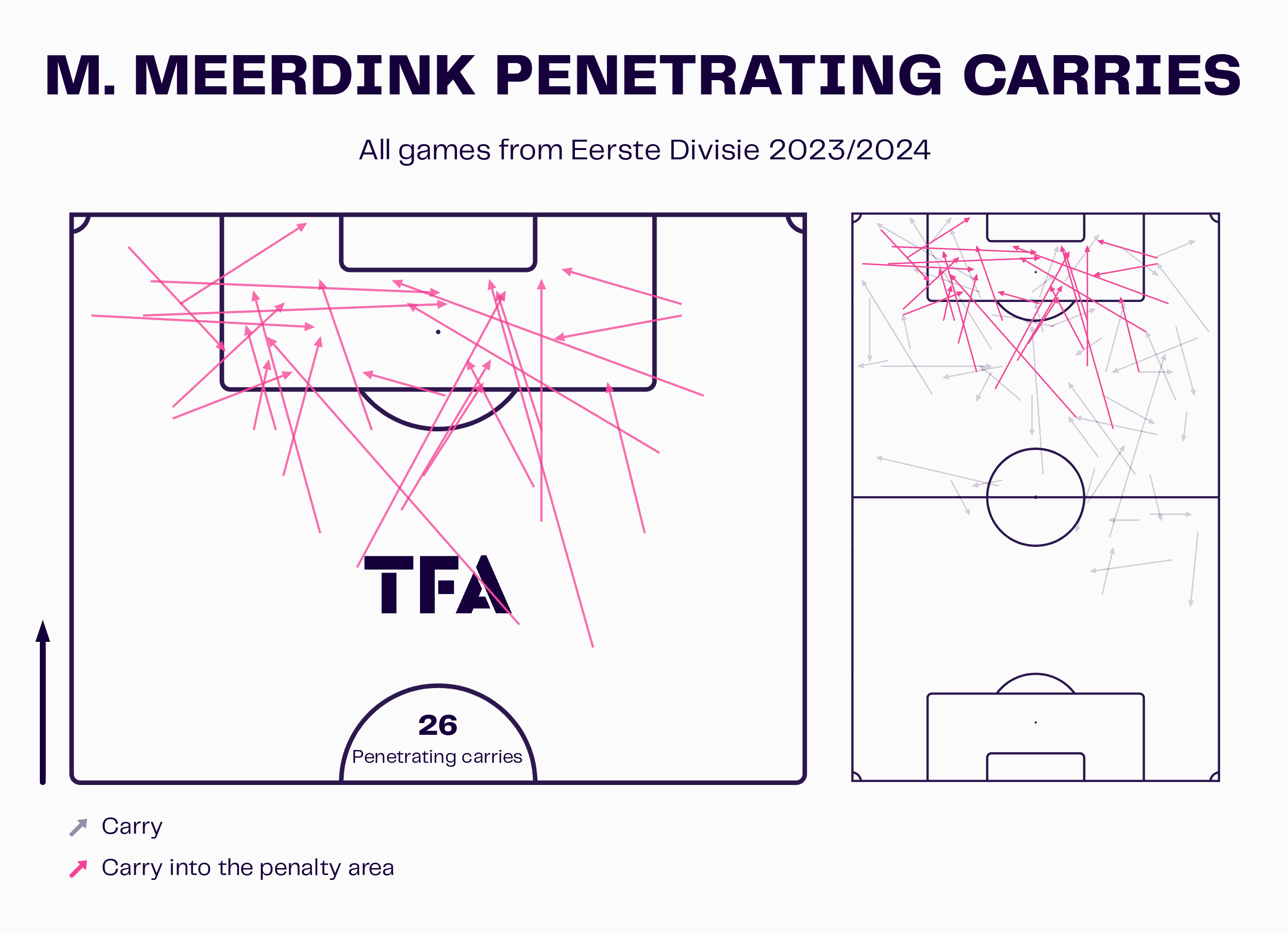
This is as true for centre-forward Mexx Meerdink as it is for any other member of the front five. While he’s listed as a centre-forward, and this will be where we most frequently find him, he roams about a lot, often positioning himself deep, as we saw in the example from figure 2 earlier, or drifting out to the wings — he’s often picked the ball up out wide and then driven inside with it, as his penetrating carries map in figure 4 depicts.
We find him operating in this way in different phases of the attack, but especially in transition to attack as a long ball forward from the back can find Meerdink running the channels and looking to exploit an attacking opportunity there.
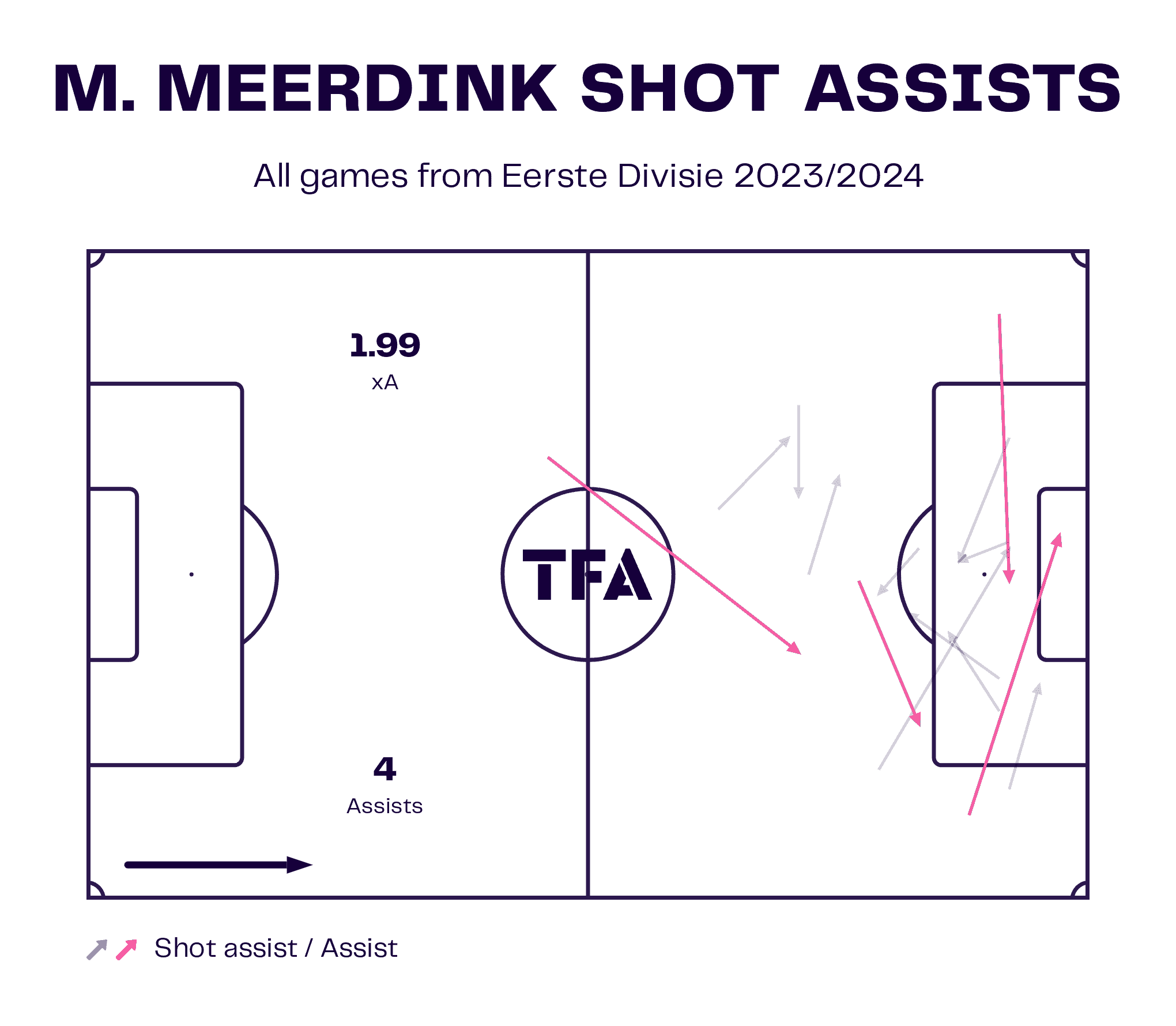
We sometimes find the centre-forward operating as something of a ‘false 9’, dropping deep to open up space for the wide forwards to come inside and attack. In these instances, Meerdink can exercise his playmaking ability, providing defence-splitting through passes for the attackers to get on the end of.
There is a case to be made that Meerdink roams a tad too much and should focus on his positioning in threatening areas in order to improve his goalscoring numbers as a centre-forward — or another teammate should always occupy those positions in his absence when he drops.
There have been times when Jong AZ have been out wide with the potential to cross the ball into a really valuable area only to be lacking a presence in that area to convert the chance, and Sierksma’s side don’t make a tonne of touches inside the final third, so this is one area they may seek improvement.
In the chance creation phase, expect to see a lot of movement and positional interchange between these players off-the-ball as they try to find space and create gaps that the team can exploit. You can also anticipate lots of link-up and short passing combinations between the members of Jong AZ’s front five as they try to find a pathway through to goal inside the final third.
Transitions
Moving on to transitions — and starting with the transition to attack — Sierksma’s side has been lethal in this phase of play this term, as you might expect from the way in which their forwards combine with off-the-ball movement to exploit space that would be perfect for a penetrative through pass on the counter.
They are really at their best in transition to attack when they can exploit their quickness and fast combinations through the centre of the pitch to try and quickly make their way through the middle of the pitch to the goal.
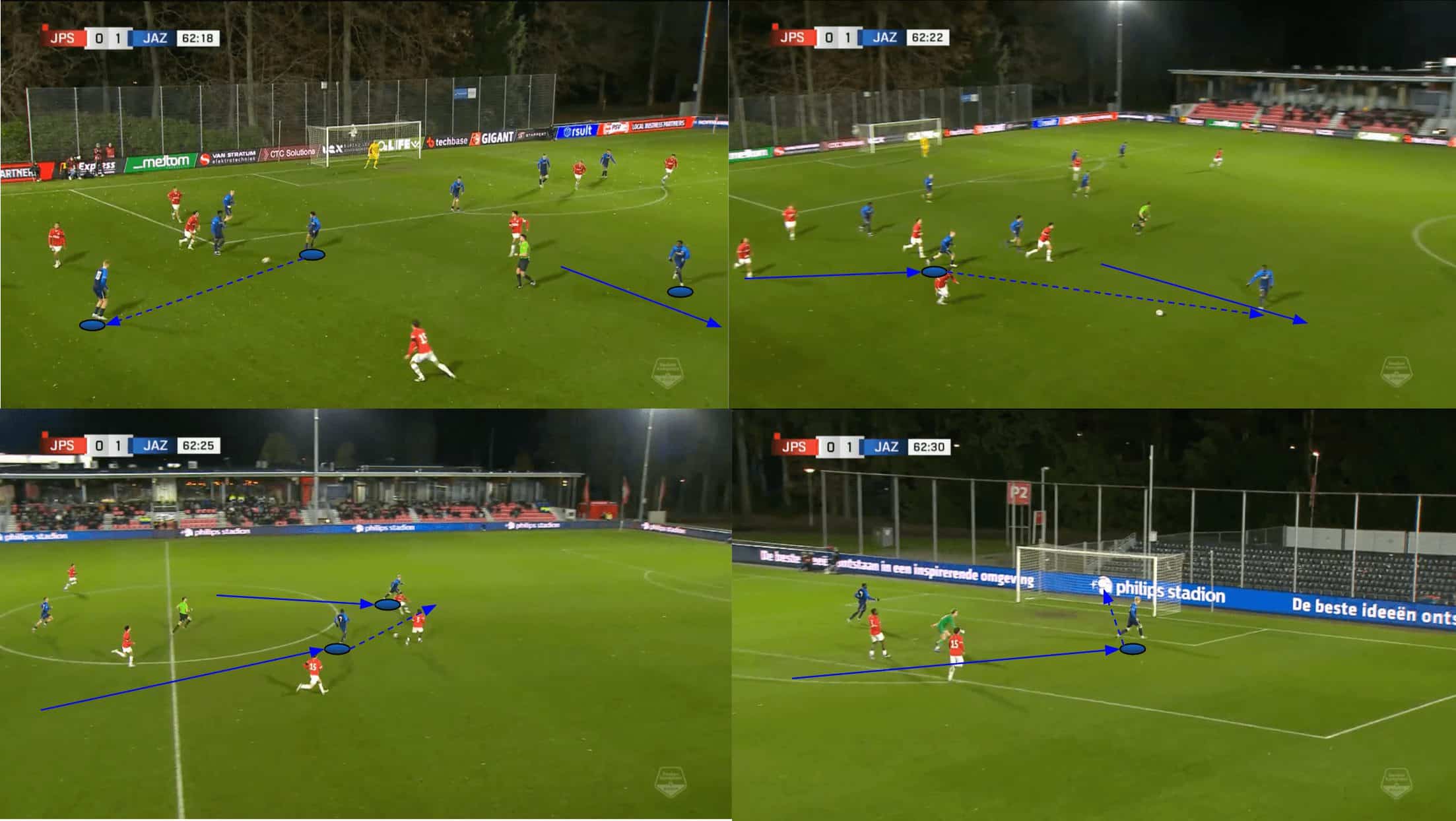
We see an example of AZ performing a successful transition to attack in figure 6. Here, after regaining possession just on the edge of their box, AZ make their way out, finding right-back Van Aken in some space.
Van Aken is able to carry the ball inside for a few steps before finding Kewal making an inviting run into space behind the opposition’s midfield line.
The winger is able to carry the ball into the opposition’s half before playing a through ball into Meerdink’s path. The striker rounds the opposition’s ‘keeper and sends the ball into the back of the net, putting AZ two goals up against Jong PSV.
The combination of ball-carrying and off-the-ball movement to open the angle from Van Aken to Kewal, along with Kewal’s dribble and perfectly timed pass through to Meerdink, topped off with the centre-forward’s finish — this passage of play is a perfect example of what Sierksma works on with his team to make them a fearsome unit in transition.
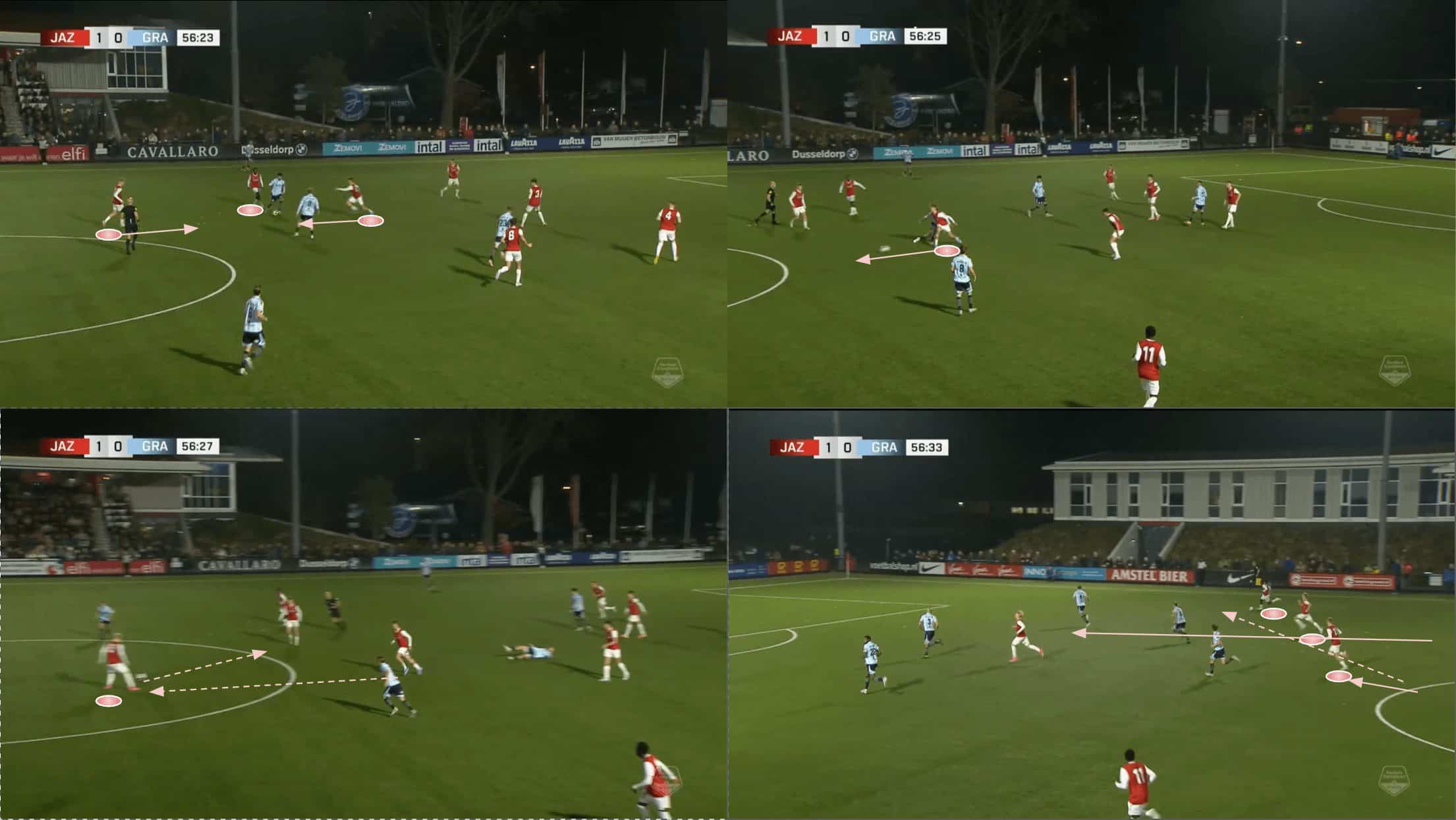
This Jong AZ side counterpress aggressively — particularly their midfielders and forwards — whether that’s high upfield or in the middle third.
In this example above, we find their right holding midfielder, right-winger and ‘10’ counterpressing the opposition’s midfielder aggressively, quickly closing all the space around him, denying him a path forward or any way out of the pressing trap in which he’s been caught.
They can find Meerdink dropping in, and offering support just behind the halfway line, and soon after, AZ are breaking away into the final third with Jayden Addai, on this occasion, receiving the ball in a slightly wider position on the right than usual — exploiting the space where it was available in transition — opening up some space inside for Van Aken to actually make an underlapping run on this occasion, moving from the right-back position to the right half-space.
I love this example because it highlights a lot of what’s great about Jong AZ’s transitional play and, indeed, attacking play this term. We find an aggressive counterpress to generate the turnover and get AZ moving into the opposition’s half. Still, before they can get there, they rely on the dynamic movement of their forward and link-up play between their offensive players.
Once they get to the final third via the through ball to Addai and the latter’s dribble, we see the positional flexibility and freedom come into play; with Van Aken interpreting the situation, seeing the overlap wouldn’t be as beneficial for the team as the underlap would just this time, and performing that run into the half-space very intelligently.
The off-the-ball movement and link-up we find Jong AZ perform is constantly changing, making them somewhat unpredictable within the framework Sierksma has set out for them to enact on field.
Out-of-possession
Our third and final section of this tactical analysis will focus on Jong AZ’s out-of-possession approach. We saw an example of how they will defend aggressively in the middle of the park when they contested for the ball in transition above in figure 7 — this level of aggression, should the opposition breach central areas in the middle of the park, is a key principle of the team’s approach, they don’t want the opposition to have any time and space in these positions and will combat them aggressively to prevent them from doing any harm from those areas.
Firstly, though, AZ will aim to prevent the opposition from ever reaching those positions in the first place, which is where we move on to discussing their press.
This team generally operate with a fairly high line and are not afraid to get stuck in high upfield, contesting the opposition’s build-up phase.
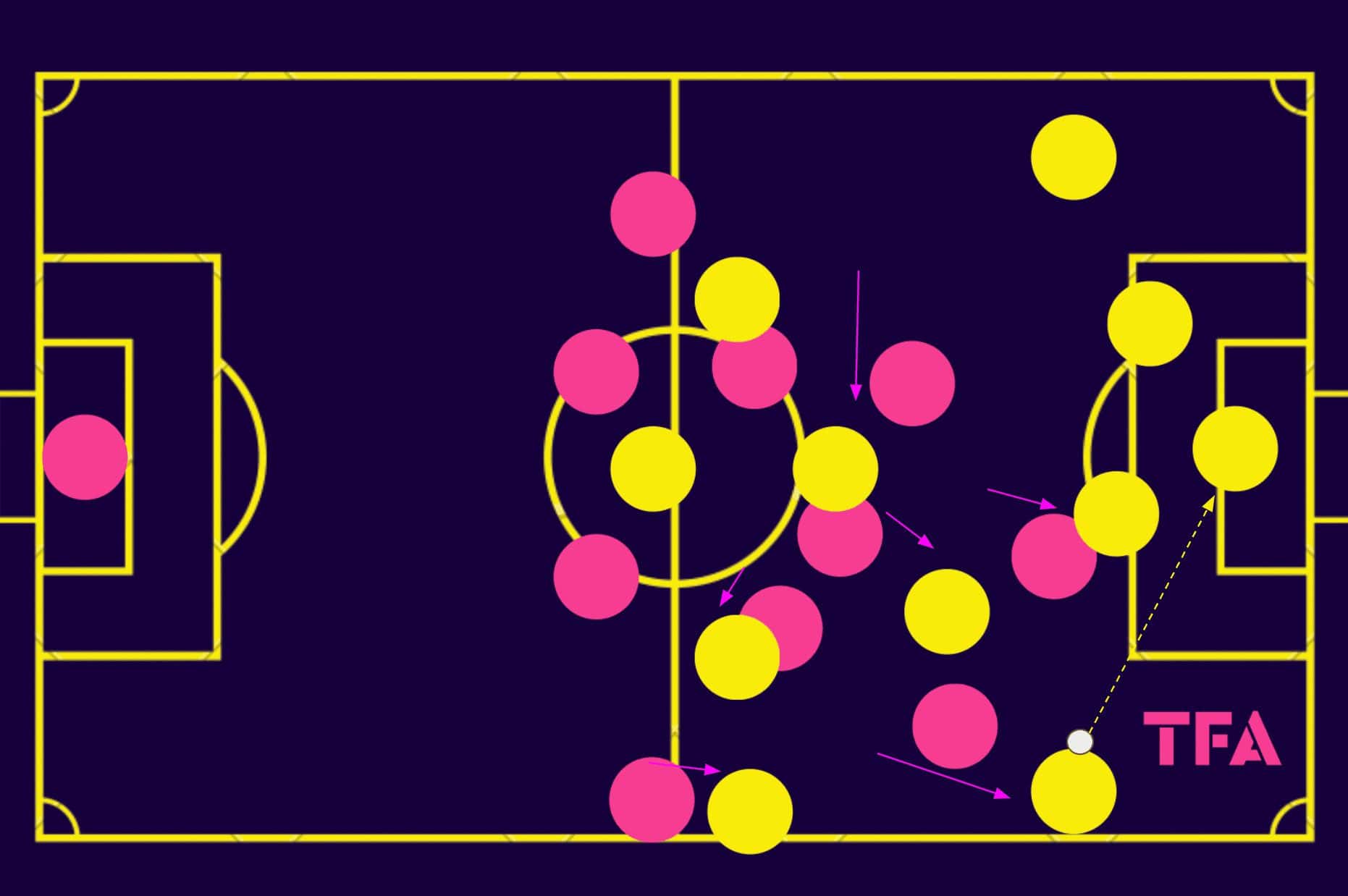
From the above example, we can see how they get fairly man-oriented in midfield, though with players sometimes switching opponents off to other defenders as the opposition moves the ball around and tries to craft a path through AZ’s defensive shape. We see AZ’s ‘10’ just about to move off the opposition’s right central midfielder in figure 8 as the left-winger makes his way over to cover that player. The ‘10’ would then push up to mark the opposition’s holding midfielder showing for the ball behind the right-winger looking to close down the ball-carrying left-back.
After forcing the play out wide via their tight marking and compact positioning in the middle of the park, AZ’s centre-forward will look to do his bit to box the opposition out wide, sitting on the ball-near centre-back. At the same time, the midfielders behind him all get tight to other nearby passing options, doing so very carefully and not leaving their man if they remain a viable passing option until another defender has picked them up.
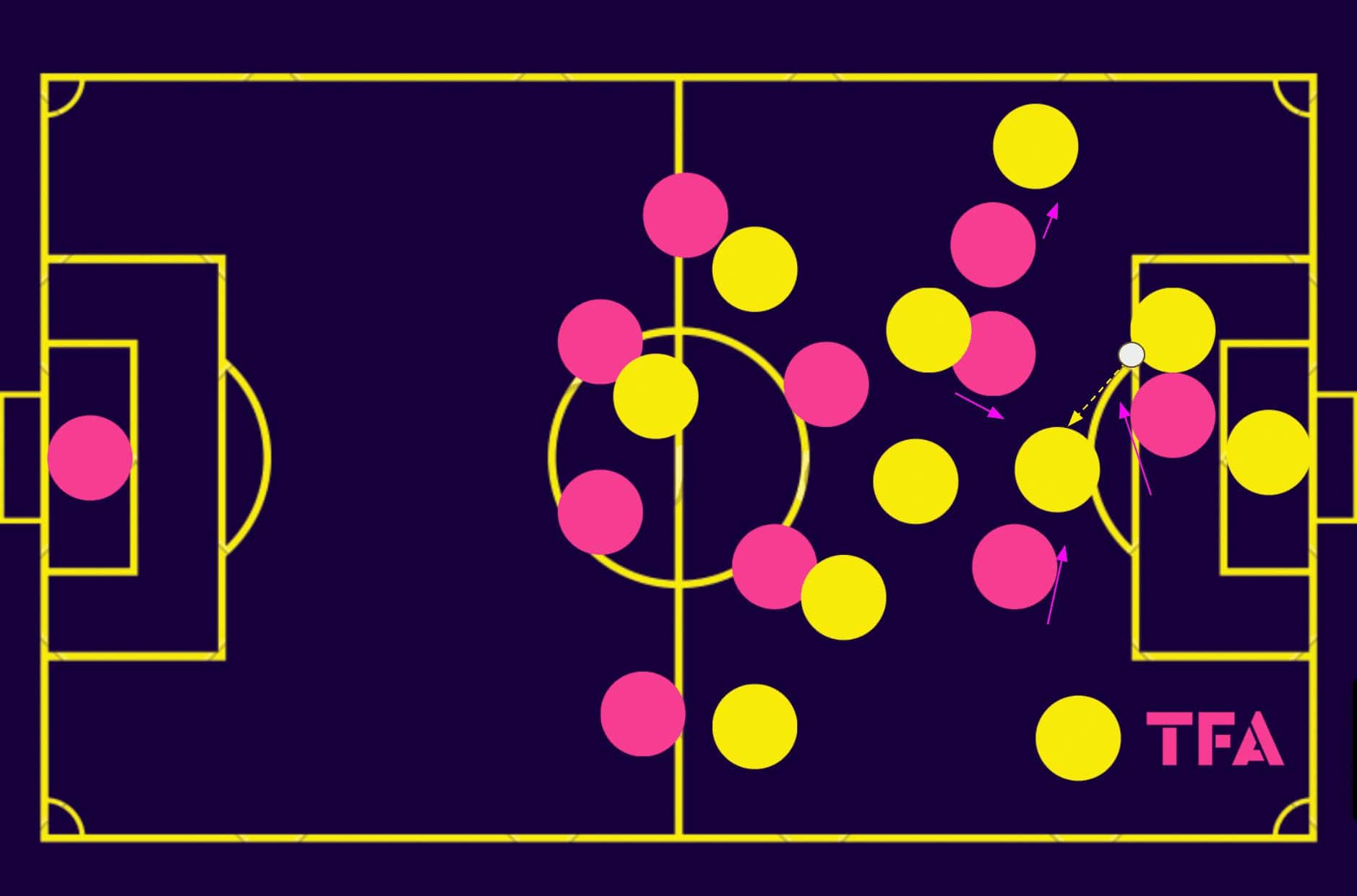
In this example, after the ball was played back to the ‘keeper, the opposition found the right centre-back in a bit of space. We see how AZ’s defensive shape adapts and shifts across in reaction to the new challenge presented to them now on the opposite side of the pitch.
On this occasion, the left-winger jumps out to block the opposition’s pathway to the right-back quickly, denying the centre-back that option while the other members of AZ’s midfield and forward lines all close down the ball carrier and pick up the near passing options.
The ball-carrier’s central defensive partner creates an angle just out of Meerdink’s cover shadow to receive, but now the opponent is in trouble, as it doesn’t seem there’s much of a chance for the new receiver, the left centre-back, to turn out.
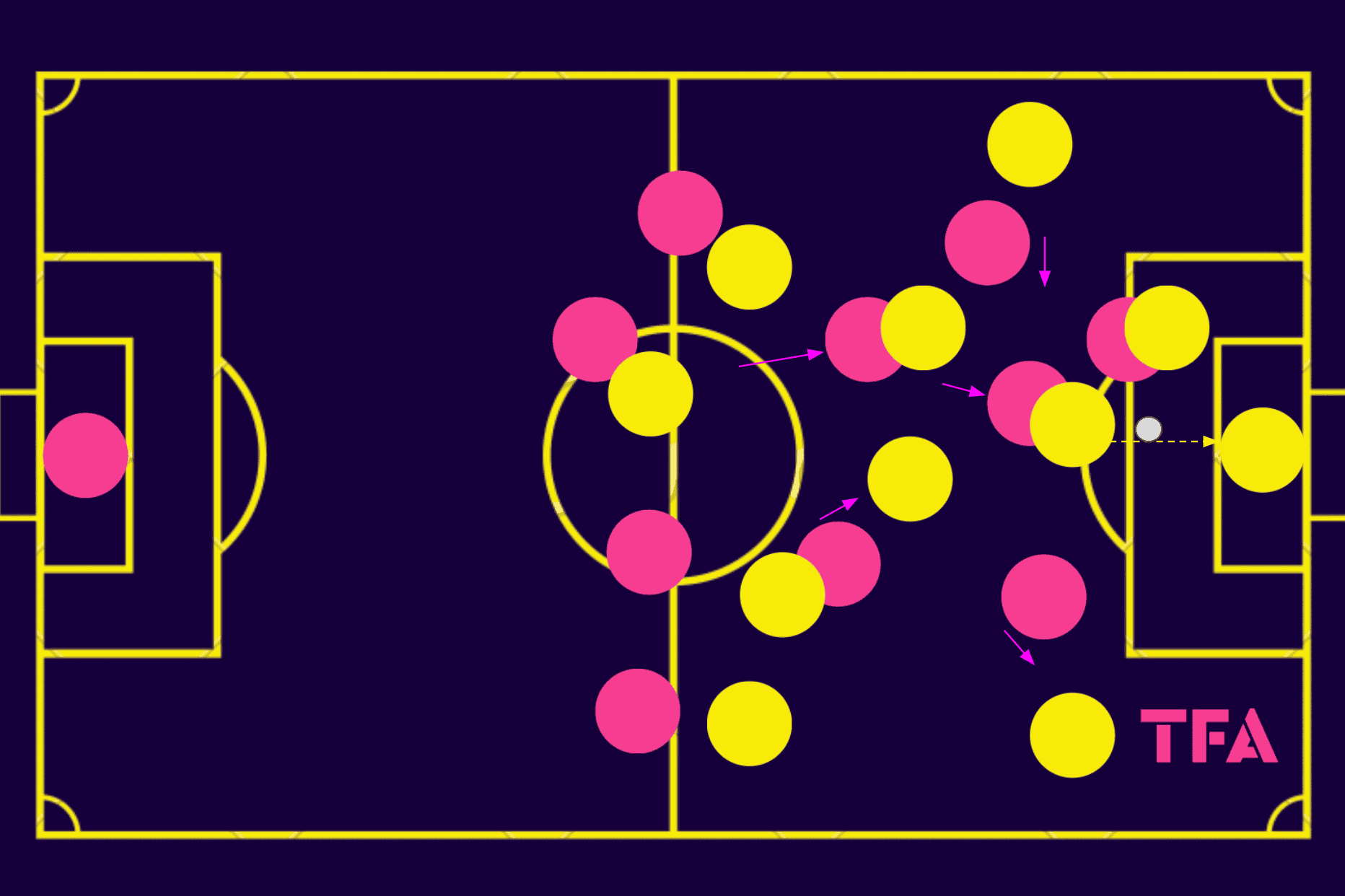
Indeed, there wasn’t, and a rushed pass back to the goalkeeper is the result. We’ve seen AZ force so many of these kinds of rushed passes back to the goalkeeper from the opposition this term. It can be very dangerous, as often the ‘keeper will not be very comfortable with the ball at their feet, meaning that AZ can really turn up the pressure at this point to close the ‘keeper down.
At this point, Meerdink will turn his attention to closing down the goalkeeper while we see all of AZ’s forwards and wingers advancing aggressively at this point to make all nearby passing options unviable.
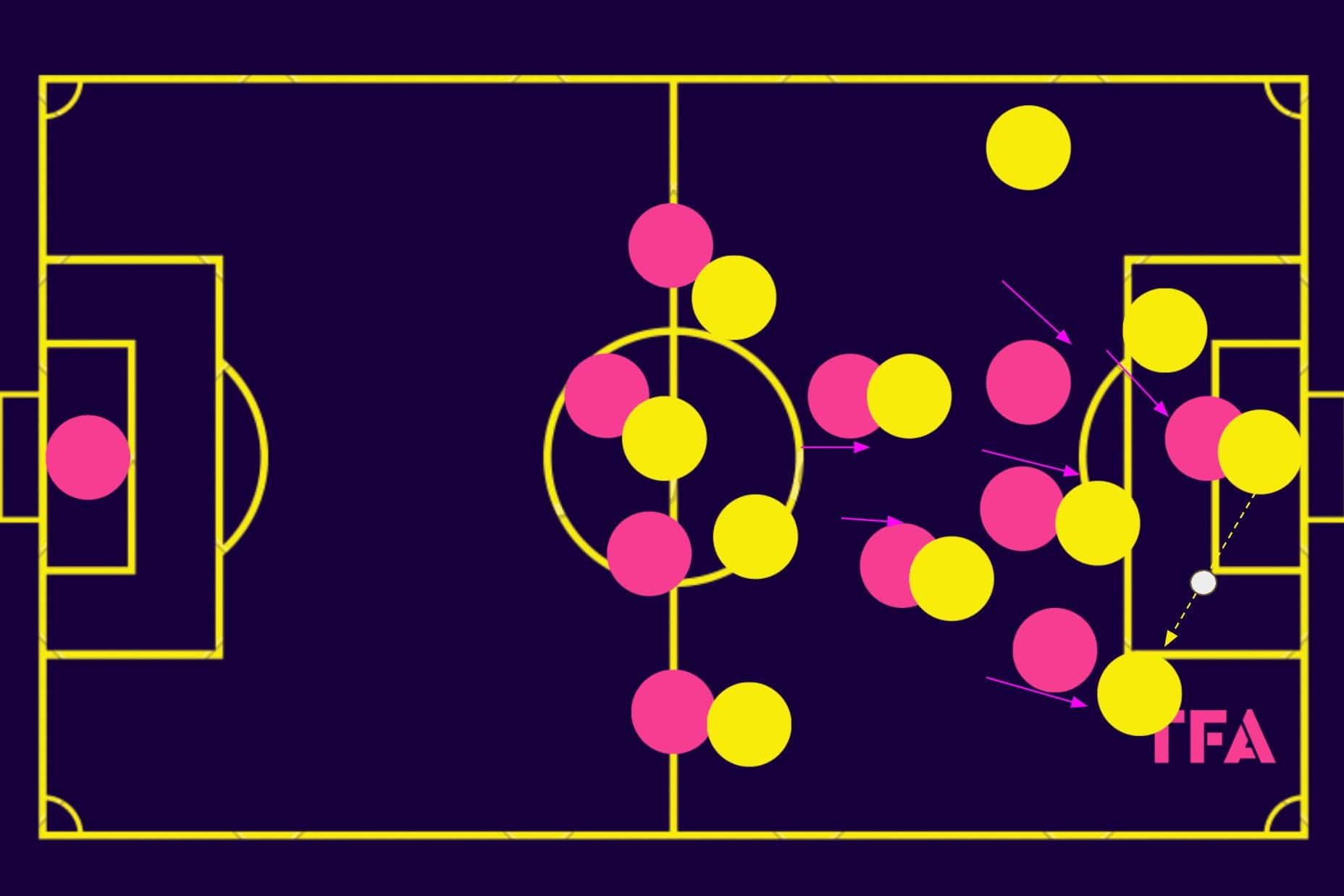
The ‘keeper finds his way out to the left-back, but now the pressure is extremely high, and there’s no way out of the press while retaining possession for the opposition.
This is a basic example from Jong AZ’s recent league game versus Cambuur, which highlights how Sierksma and his coaching team have designed their press to function.
It can take some persistence to force the turnover at times, but when organised and committed to the defensive effort, they can successfully prevent the opposition from advancing and force a favourable turnover in a valuable position.
When defending deeper, we still typically find Jong AZ defending in a 4-2-3-1 — though that shape will often transition into a 5-4-1 in the low-block, with one of Sierksma’s holding midfielders moving into the backline.
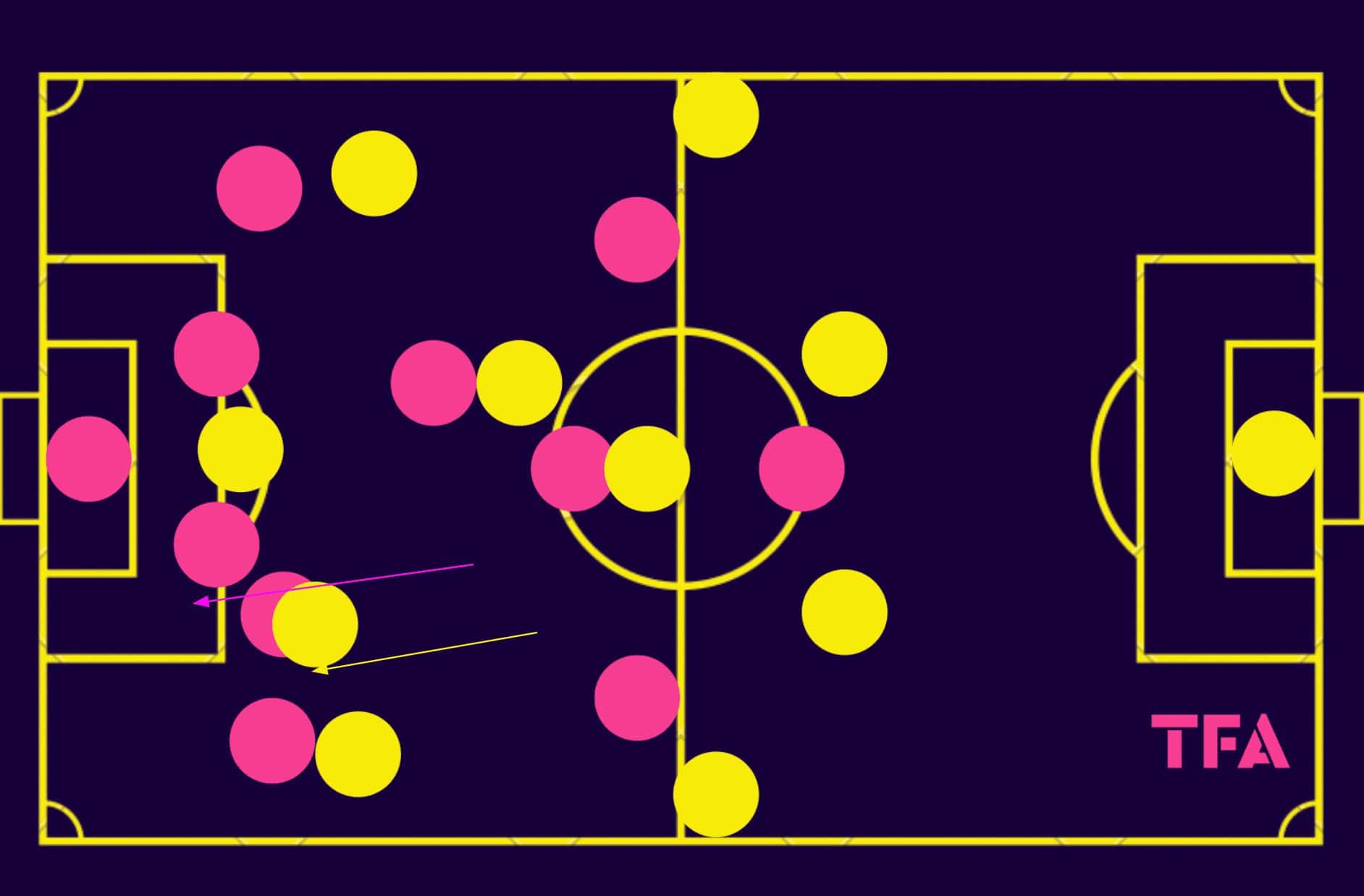
The critical thing to note about Sierksma’s holding midfielders in the low block is that they are responsible for controlling the half-spaces and any movement from or to them. As a result, for instance, when the opposition’s left central midfielder tries to exploit the space between AZ’s right-back and right centre-back here, their right holding midfielder follows him, ensuring he doesn’t become a free man in a valuable area.
If the opponent stays high, the holding midfielder will also create the 5-4-1 shape. AZ would typically be far more compact around the edge of the box by that point, so the gap left in midfield by the holding midfielder would typically be far less pronounced than it appears in figure 12, but we’ll use this as an example purely for the holding midfielder’s movement in the low-block phase.
Conclusion
To conclude this tactical analysis piece, Jong AZ have a coach in charge of their team, developing their young players who has thrived at youth level and won everything there was to win with the U19s while helping the club develop the likes of Mexx Meerdink, Ernst Poku (who has made three Eredivisie assists this term having been part of Sierksma’s U19s last term) and Jayden Addai all become very exciting prospects that could propel the first team to new heights in the future should they maintain their current levels of development.
An academy needs investment, but that comes in the form of money as well as coaching knowledge, and Sierksma has been a great provider of the latter to his young players throughout his time with AZ — now getting them competing at a decent level in the Eerste Divisie despite having the fourth-youngest team (19.5) in that division.
Keep an eye on Sierksma, as he should be a name we see a lot more of over the next 12 months and further on into the future.

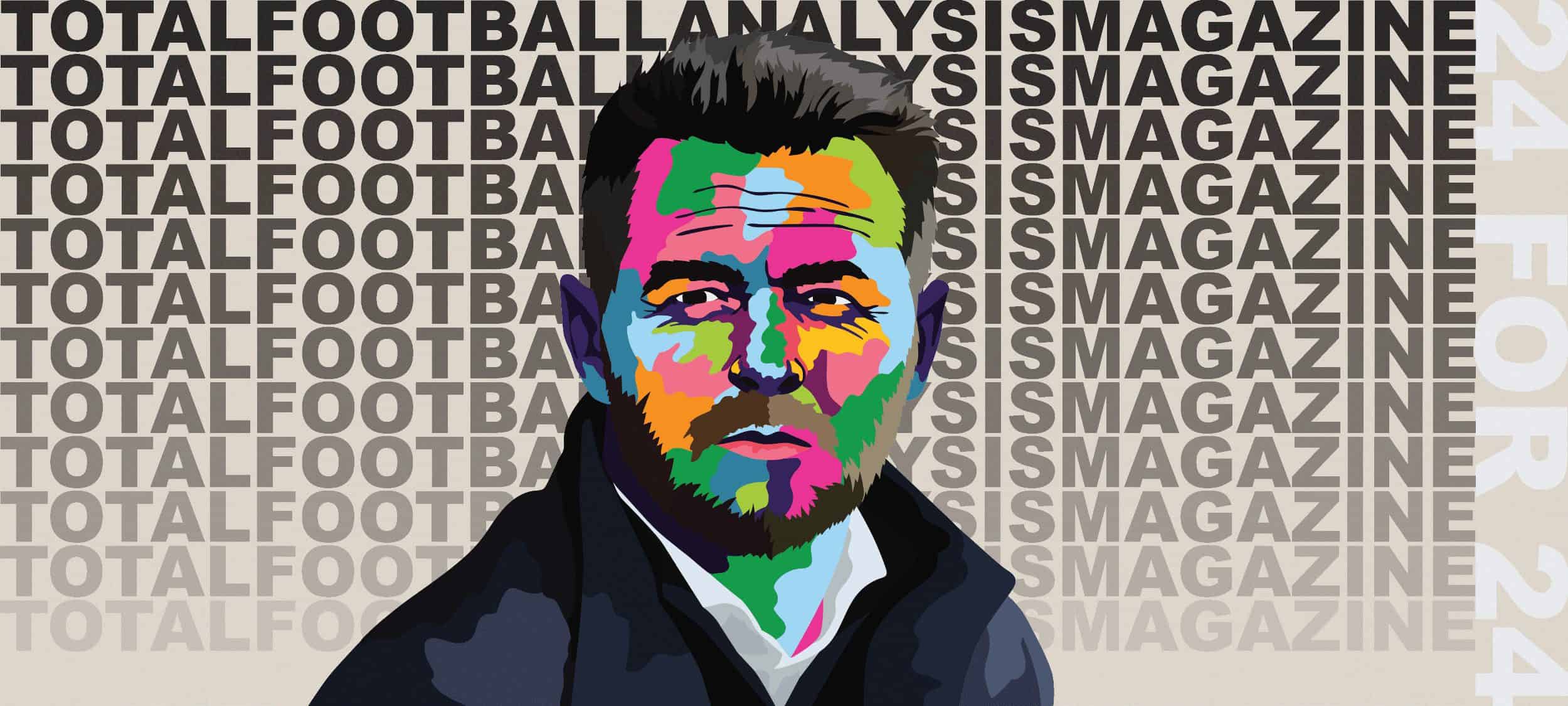



Comments